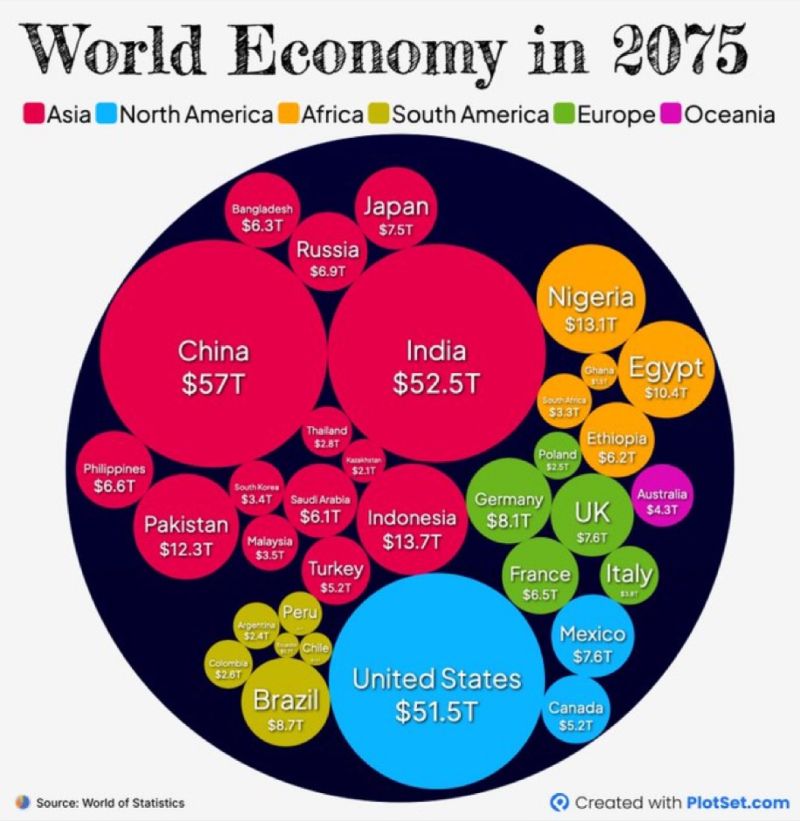
According to a recent report by Goldman Sachs, the world’s economic landscape will undergo significant changes by 2075. The report predicts that the global GDP will grow by more than four times, reaching $280 trillion, and that the share of emerging markets will increase from 40% to 75%.
The report also forecasts the ranking of the top 10 economies by nominal GDP in 2075, based on factors such as demographics, productivity, investment, trade, and technology. Here are the main highlights of the projection:
China will remain the largest economy in the world, with a GDP of $80 trillion, accounting for 29% of the global output. China’s growth will be driven by its large population, high savings rate, and technological innovation.
Register for Tekedia Mini-MBA edition 19 (Feb 9 – May 2, 2026): big discounts for early bird.
Tekedia AI in Business Masterclass opens registrations.
Join Tekedia Capital Syndicate and co-invest in great global startups.
Register for Tekedia AI Lab: From Technical Design to Deployment (next edition begins Jan 24 2026).
India will overtake the US as the second-largest economy, with a GDP of $66 trillion, representing 24% of the world’s GDP. India’s growth will be fueled by its young and growing workforce, rising urbanization, and digital transformation.
The US will slip to the third place, with a GDP of $34 trillion, or 12% of the global GDP. The US will face challenges such as aging population, fiscal deficit, and geopolitical tensions.
Indonesia will emerge as the fourth-largest economy, with a GDP of $10.5 trillion, or 4% of the world’s output. Indonesia’s growth will be supported by its large and youthful population, abundant natural resources, and strategic location.
Brazil will rank fifth, with a GDP of $8.5 trillion, or 3% of the global output. Brazil’s growth will be boosted by its rich agricultural and mineral resources, diversified industrial base, and expanding consumer market.
Nigeria will climb to the sixth place, with a GDP of $7.5 trillion, or 3% of the world’s GDP. Nigeria’s growth will be driven by its huge population, abundant oil and gas reserves, and improving governance and infrastructure.
Russia will fall to the seventh place, with a GDP of $7 trillion, or 2.5% of the global output. Russia’s growth will be constrained by its declining population, low productivity, and dependence on energy exports.
Japan will drop to the eighth place, with a GDP of $6.5 trillion, or 2% of the world’s GDP. Japan’s growth will be hampered by its aging population, low birth rate, and high public debt.
Mexico will rise to the ninth place, with a GDP of $6 trillion, or 2% of the world’s output. Mexico’s growth will be aided by its proximity to the US market, diversified economy, and competitive manufacturing sector.
Germany will slide to the tenth place, with a GDP of $5.5 trillion, or 2% of the world’s output. Germany’s growth will be limited by its shrinking population, high labor costs, and trade uncertainties.
The report concludes that the world will witness a shift in economic power from the advanced economies to the emerging markets in the next five decades. It also warns that this transition will pose significant challenges and opportunities for policymakers, businesses, and investors around the world.
Some of the challenges for policymakers are:
How to ensure fair and inclusive growth across different regions and countries.
How to balance environmental sustainability and economic development.
How to foster innovation and competitiveness in a rapidly changing global market.
How to manage geopolitical risks and conflicts arising from diverging interests and values.
How to cope with social and political changes resulting from demographic shifts and cultural diversity.
Some of the opportunities for policymakers are:
How to leverage the potential of emerging markets as new sources of demand and supply.
How to enhance regional and global cooperation and integration for mutual benefit.
How to promote human capital development and social welfare for all.
How to harness technological advances and digitalization for productivity and efficiency.
How to create resilient and adaptable institutions and policies for long-term stability.

A Great Insights here
Goldman Sachs’ future projections of the world’s largest economies by 2075 indicate a significant reshaping of the global economic landscape. The rapid ascendance of emerging economies such as India, Indonesia, Nigeria, and Pakistan underscores the potential of these nations, propelled by large youthful populations, improving education, and rapid urbanization.
China is predicted to rise as the world’s largest economy, signifying the enduring success of its unique economic model. India is also projected to leap ahead, underpinned by progress in innovation and technology, rising capital investment, and favorable demographics.
Meanwhile, the United States, though forecasted to nearly double its current economy of $26.5 trillion to around $51.5 trillion, is expected to fall behind China and India. This reflects a shift of economic clout towards Asia, but also highlights an impending challenge: an escalating U.S. National Debt projected to reach 250% of its GDP by 2075, resulting in a staggering total debt nearing $125 trillion.
The emergence of Indonesia and Nigeria among the top five economies underscores the vast potential of these countries, given their strategic location, abundant natural resources, and significant population size. Similarly, the inclusion of Pakistan and Egypt in the top ten illustrates expected robust growth in the MENA and South Asian regions.
Contrastingly, established economic powerhouses such as Germany, UK, Japan, and France appear to be slipping down the ranks, reflecting the ongoing shifts in global economic dynamics. This decline may be due to an aging population, stagnating productivity, and challenges in innovation.
In Latin America, Brazil continues its dominance, but the rise of Mexico is noteworthy. Africa also sees increased representation with Nigeria, Egypt, and Ethiopia signaling potential growth and development across the continent.
These projections depict the emergence of a new world order, where developing nations could play a more substantial role in the global economy. Yet, it’s crucial to remember these are only predictions, and actual outcomes may differ due to factors like political stability, global climate change, technological advances, and unforeseen economic shifts.




is this report correct?